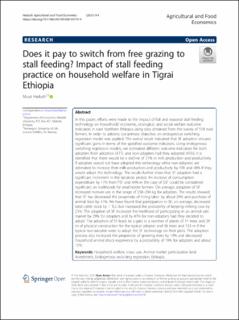| dc.contributor.author | Gebremichael, Muuz Hadush | |
| dc.date.accessioned | 2022-02-25T07:44:32Z | |
| dc.date.available | 2022-02-25T07:44:32Z | |
| dc.date.created | 2021-06-28T18:42:06Z | |
| dc.date.issued | 2021 | |
| dc.identifier.citation | Agricultural and Food Economics (Agric. food econ.). 2021, 9 (4), . | en_US |
| dc.identifier.issn | 2193-7532 | |
| dc.identifier.uri | https://hdl.handle.net/11250/2981351 | |
| dc.description.abstract | In this paper, efforts were made to the impact of full and seasonal stall feeding technology on households’ economic, ecological, and social welfare outcome indicators in rural Northern Ethiopia using data obtained from the survey of 518 rural farmers. In order to address our primary objective, an endogenous switching regression model was applied. The overall result indicated that SF adoption ensures significant gains in terms of the specified outcome indicators. Using endogenous switching regression models, we estimated different outcome indicators for both adopters from adoption (ATT), and non-adopters had they adopted (ATU). It is identified that there would be a decline of 21% in milk production and productivity if adopters would not have adopted this technology while non-adopters are estimated to increase their milk production and productivity by 100 and 48% if they would adopt this technology. The results further show that SF adoption had a significant increment in the lactation period. An increase of consumption expenditure by 17% from FSF and 44% in the case of SSF could be considered significant on livelihoods for smallholder farmers. On average, adoption of SF increased manure use in the range of 258–294 kg for adopters. The results showed that SF has decreased the propensity of hiring labor by about 29% and purchase of animal feed by 31%. We have found that participation in SF, on average, decreased total cattle stock by 1 TLU but increased the probability of keeping milking cow by 23%. The adoption of SF increased the likelihood of participating in an animal sale market by 29% for adopters and by 47% for non-adopters had they decided to adopt. The adoption of SF leads to a gain in a number of plants of 11 trees and 29 m of physical construction for the typical adopter and 36 trees and 133 m if the typical non-adopter were to adopt the SF technology on their plots. The adoption process also increased the propensity of growing trees by 19% and decreased household animal shock experience by a probability of 19% for adopters and about 15%. | |
| dc.language.iso | eng | en_US |
| dc.title | Does it pay to switch from free grazing to stall feeding? Impact of stall feeding practice on household welfare in Tigrai Ethiopia | en_US |
| dc.type | Journal article | en_US |
| dc.type | Peer reviewed | en_US |
| dc.description.version | publishedVersion | |
| dc.source.pagenumber | 0 | en_US |
| dc.source.volume | 9 | en_US |
| dc.source.journal | Agricultural and Food Economics (Agric. food econ.) | en_US |
| dc.source.issue | 4 | en_US |
| dc.identifier.doi | 10.1186/s40100-020-00170-4 | |
| dc.identifier.cristin | 1919107 | |
| cristin.ispublished | true | |
| cristin.fulltext | original | |
| cristin.qualitycode | 1 | |
